Part I: Are Manufactured Housing Communities (MHCs) a Good Investment?
Editor’s Note: This is the first in a four-part series of the exclusive interview George F. Allen gave MHMSM.com Industry in Focus Reporter Matthew J. Silver.
MHMSM: You’ve stated that an estimated 15 percent of all manufactured housing communities are in the hands of portfolio operators. What is your guesstimate of the total number of manufactured housing sites in the U.S.? Given this number, how many sites would be in the hands of portfolio operators and how many with independent ‘mom and pop’ owners?
George F. Allen (GFA): The generally accepted number of manufactured home communities is 50,000. For several reasons we may never know the exact amount, mainly because that type of property is regulated in only about a dozen states. It goes back to the early days when bathrooms were not required to be in ‘trailers;’ therefore, if you were going to have a trailer park*, you would have to have a gang shower and a gang bathroom. The board of health would inspect to make sure these facilities existed for the general health of the public.
That is a law that’s been around for many years in these 12 states that’s never sunsetted [been taken off the books]. In other words, once they started these inspections, they didn’t want this source of revenue to dry up. But once manufactured homes started having bathrooms inside, the major need to inspect mobile homes* no longer existed.
The problem is, from state to state, the threshold, or what constitutes a mobile home park*, varies. It could be as few as three or four sites in Indiana, which is not really an investment size property, and a different threshold in Ohio or Illinois. So if you have a different baseline in every state, you are never going to know. And since 38 states don’t have a list of the communities, we’re never going to really know.
When I was writing my second textbook about the development, marketing and operation of manufactured home communities in 1992, I went to the state board of health to get their list of the 1100 manufactured home communities in Indiana.
What I came up with was – and I compared it to other states – because of the extremely low number of sites that constituted a manufactured home community, 85 percent of the properties in most states were properties of 100 sites or smaller, with a few exceptions. And that’s important because those are referred to as ‘mom and pop’ operations, because they lack the economies of scale to be a really strong source of passive investment income. It’s not until you get to 150 or 200 sites or larger that the economies of scale will support a remote property management operation. The average size property in portfolios today is around 222 sites, because it takes that many to support a centrally located management operation. The exceptions I referred to earlier are Florida, Arizona and California, where the percentage is more like 78 percent, because there are a larger number of retirement properties in the Sunbelt states. So, of the remaining 15 percent in the other states, six and a half are over 200 sites. This remaining 15 percent is in the hands of 500 individuals, partnerships, and corporations.
According to the Allen Report, the average portfolio is estimated to be 24 properties for each player. Granted, you could have five little communities or one big 500 site community to get on my list. But at the other end of the spectrum is Sam Zell, who owns three or four hundred communities. He’s the biggest player in the world. When Buffett bought Clayton, he acquired 60 communities, but he owned them for only a couple of years and then sold them. They are now owned by a company called YES! Any properties over 200 sites we call institutional or investment grade properties, because the return on the investment is so great, that’s what the big money goes after. The 100 to 200 site owners I call the young wealth builders. They want to play in this arena, and they are bigger than the ‘mom and pop’ operators, but they can’t compete in the same field as the Sam Zells of the world, so they content themselves with two properties, ideally in the same town, so they can have one management team look after them.
MHMSM: You have a good idea of how many people it takes to manage and maintain a manufactured housing community (MHC). While it would certainly vary, based on the size of the community, based on your experience, from the community manager or owner, to maintenance, sales and support people who might work on an as-needed basis, what do you think a typical MHC employment would look like? Given this number, how many do you think are employed by MHCs nationwide when there are an estimated 50,000 MHCs in the U.S.?
GFA: The answer to that is counter intuitive. If we were talking about apartment communities here, the more people living in the apartments, the larger the staff has to be. Statistics show there is a 60 percent turnover rate in apartments, which means you have to paint the rooms when someone moves out, clean the carpet, maintain the appliances and mechanical parts, have a leasing staff and maintenance. Plus you have to mow the grass. At an MHC, there’s only five to ten percent turnover every year. But people own their homes, they are responsible for taking care of everything in their house, inside and out, and they cut their own grass. That means a lot less staff. Proportionally, the larger a community gets, the fewer staff people necessary. I would say a 200 site community would require a full time manager, a part-time assistant, and one and a half guys working outside, mostly maintaining sites not occupied and policing the trash. It would take only half that many people to operate a 100 site community. I would estimate there are fewer than a thousand full time employees of manufactured housing communities.
MHMSM: How many people do you estimate live in MH Communities?
GFA: Ask Thayer Long.
MHMSM: How many vacancies do you estimate there are in MHCs?
GFA: Just under ten percent vacancy.
MHMSM: How difficult do you think it would be to mobilize these residents and employees of MHCs into following an agenda the “protects and promotes” regulations and laws that govern the purchasing, financing and overall well being of their communities?
GFA: That’s a loaded question. It depends so much on whether or not they already have landlord-tenant legislation. In California and Florida, that bridge has already been crossed. But if you’re talking about the Midwest, the answer becomes more germane, because it depends on two things: How bad the abuses are by the landlords, and how intelligent, socially conscious and activist-oriented the tenants are in those properties. Those are two very subjective factors. Without an answer to those, I can’t give you an answer to your question.
MHMSM: Some operators focus only on used and repossessed homes for their sales. Why is it important for community operators to sell new homes?
GFA: Someone’s making an assumption. Some operators prefer to buy used and repossessed homes and I ‘m one of them. The reason is, there’s a greater margin for profit. If I can buy a slightly used home for five or ten thousand dollars, put in a couple of thousand dollars in new carpet, new appliances, and turn around and retail it for 18 or 20 thousand dollars, that’s a good return. Then I give the buyer terms they can afford so I make money on the interest and money on the ground rent as well. The main advantage to me of a new home is it upgrades the community. The biggest problem I have with buying new homes is, unless you buy a half dozen or a dozen at a time and get a significant discount on the price, you’re going to take a hit on the depreciation. It’s like an automobile. If it’s not attached to the ground, it loses its value instantly. We don’t like to talk about that in the industry, but that’s what happens. Over time, it will hold its value, and the community will look nice and be worth more. But the general trend is a new home will depreciate, because the homes are still considered ‘mobile.’
MHMSM: What makes an MHC a good investment?
GFA: Look at page nine of my Allen Report.
Number one is scarcity. There is no money available to develop new ones, there’s no money for third party financing for homes, and local planning commissions are beset by NIMBY – ‘not in my back yard.’
Stable occupancy. Thirty years ago you could back your pickup truck to your 12 x 40 factory-built home and move it out. Today it costs thousands to move your home from one side of town to the other.
Stability, competitive homesite rent.
Low operating expense.
Let me take you through an example. If you and I each had $75,000 to invest, we could either buy a 100 unit apartment building with that $150,000 or buy a three hundred homesite factory-built community. First of all, each one would return about the same amount of income. Secondly, 60 percent of the tenants in the apartment building won’t be there a year from now. In a landlease community, only ten percent of the residents will move in a typical year (five percent of the home). The consequences of people moving out of apartment communities is the manager has to repaint the unit, clean the carpets, service appliances, and advertise widely, to find and attract prospective tenants. Staff winds up working seven days a week. However, in a land lease community, when your occupancy rate reaches 90 percent or higher, it’s hardly necessary to advertise at all.
You may have to pick up some loose trash around a homesite, but the responsibility is a lot less. Now how does that translate into dollars? According to national averages, in an apartment community, 55 percent of all the rent that comes in has to go back out for operating expenses. Seven days a week, mowing the grass, extra maintenance guys painting the walls, cleaning the floors, advertising expense. If we leverage that apartment building and pay interest on the loan, 40 percent of that 45 percent left over goes for interest on the loan. That means we will split five cents of every dollar we take in. For the factory-built community, for every dollar we take in, 40 cents goes for operating expenses. That’s 15 cents more we make, and we don’t have to work seven days a week. But if we’re talking about the Sam Zells of the world who have 400 or 600 home site communities, that expense figure drops to about 20 cents. So if the 150 site community doubles to 300 sites, our expenses don’t really increase. So, on the bigger communities, if we have the same leverage of 40 percent, we would split 60 percent.
*Terms used by GFA.
Next week: Part II: The Allen Report on Manufactured Housing Community Portfolio Operators: Then, Now and Tomorrow #




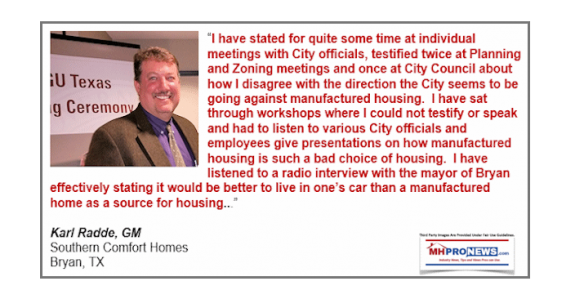

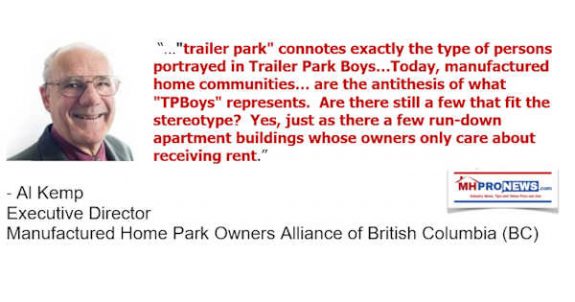


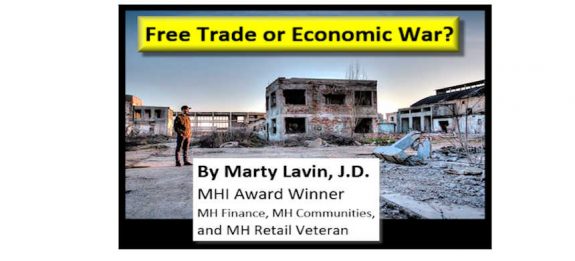


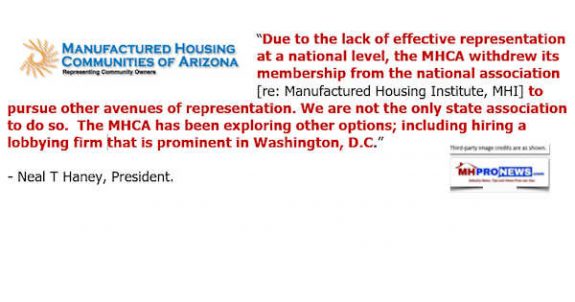

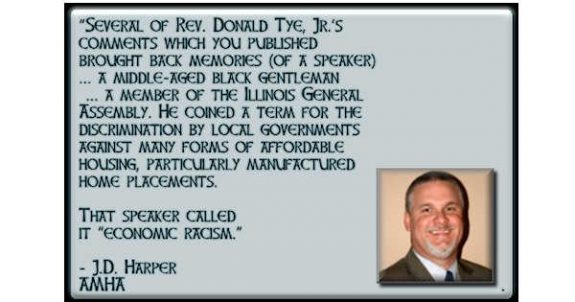
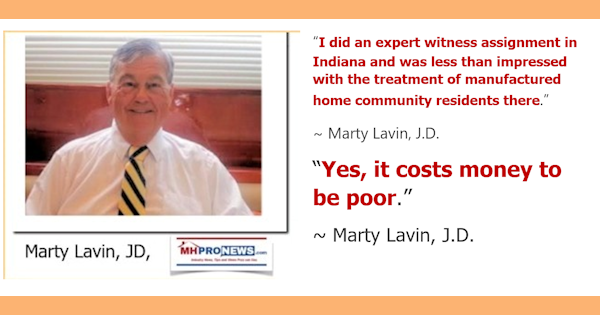
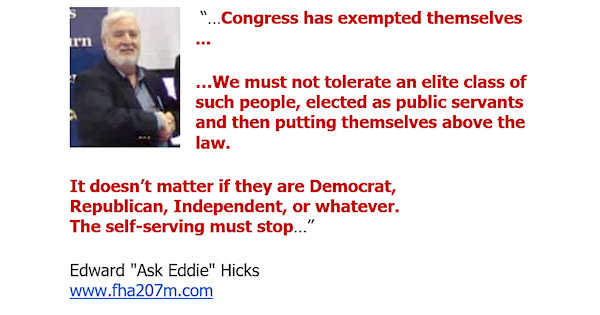

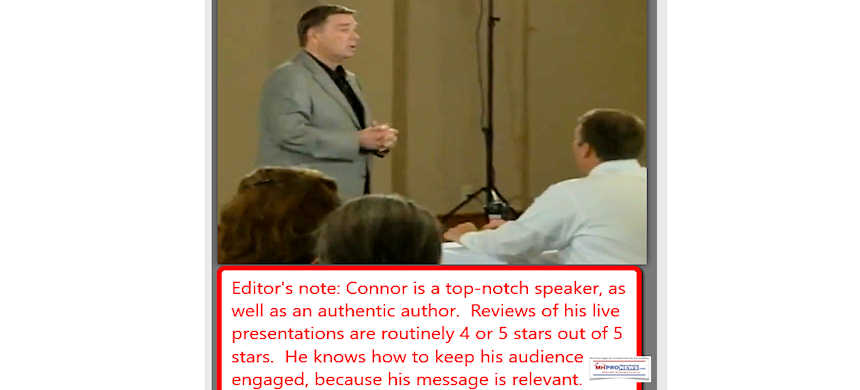

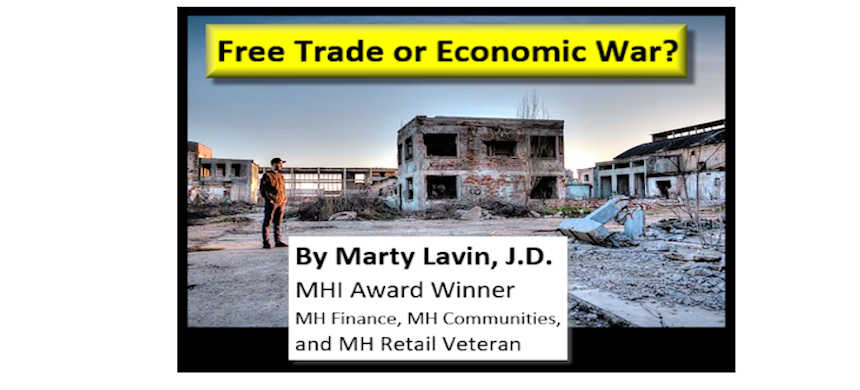





Karl Radde – TMHA, MHI, Southern Comfort Homes – Addressing Bryan City Leaders, Letter on Proposed Manufactured Home Ban
To All Concerned [Bryan City Officials, Others]: As the retail location referenced by Mr. Inderman, I would like to take a moment to address the …